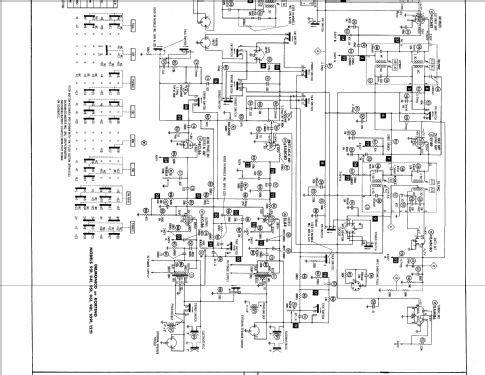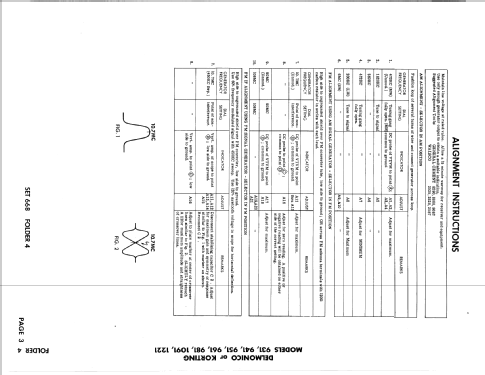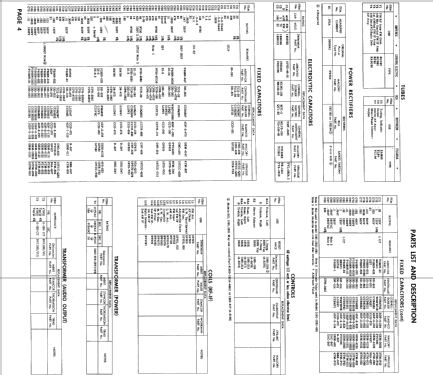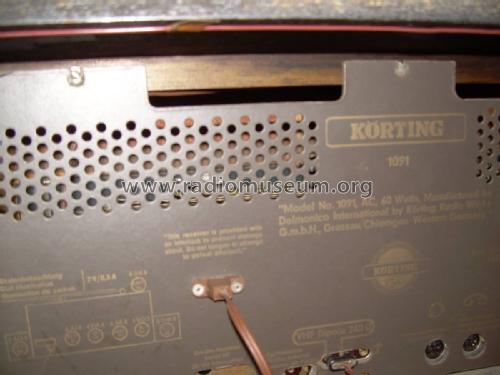Körting-Delmonico 1091 Ch= 24611
Körting-Radio; Leipzig, später Grassau
- Country
- Germany
- Manufacturer / Brand
- Körting-Radio; Leipzig, später Grassau
- Year
- 1963 ?

- Category
- Broadcast Receiver - or past WW2 Tuner
- Radiomuseum.org ID
- 221869
-
- alternative name: Dietz & Ritter GmbH, Dr.
Click on the schematic thumbnail to request the schematic as a free document.
- Number of Tubes
- 7
- Main principle
- Superheterodyne (common); ZF/IF 472 kHz; 2 AF stage(s)
- Wave bands
- Broadcast, Long Wave, Short Wave plus FM or UHF.
- Details
- Changer (Record changer)
- Power type and voltage
- Alternating Current supply (AC) / 60 Watt, 60 cycles, 117 volt for 110 - 120 Volt
- Material
- Wooden case
- from Radiomuseum.org
- Model: Körting-Delmonico 1091 Ch= 24611 - Körting-Radio; Leipzig, später
- Shape
- Console, Lowboy (legs < 50 %).
- Notes
- Delmonico International, a division of Thompson-Starrett Co., Inc., in 120-20 Roosevelt Avenue, Corona 66, New York imported at least chassis, perhaps the full radio from different companies. One was Körting-Radio in Germany. SAMS Photofact set 668, folder 4 from December 1963 shows for the same chassis/schematic the following Körting-Delmonico models: 931, 941, 951, 961, 981, 1091 and 1221. The models or the owner manual may also show a suffix - like 931A etc. The chassis are the German domestic Excello Stereo Chassis 24611 for music console 23661 - but at least the transformer (110-120 volts) and scale were changed for export. They receive "Low Wave" 150 to 360 kHz, Broadcast 515 to 1620 kHz, Short Waves 8.5 to 19.3 MHz and FM 88 - 108 MHz. They all have a record changer for 4 speeds and a stereo amplifier.
- Literature/Schematics (1)
- Photofact Folder, Howard W. SAMS (Set 668, Folder 4 from December 1963)
- Author
- Model page created by Ernst Erb. See "Data change" for further contributors.
- Other Models
-
Here you find 822 models, 675 with images and 473 with schematics for wireless sets etc. In French: TSF for Télégraphie sans fil.
All listed radios etc. from Körting-Radio; Leipzig, später Grassau
Collections
The model Körting-Delmonico 1091 is part of the collections of the following members.
Forum contributions about this model: Körting-Radio;: Körting-Delmonico 1091 Ch= 24611
Threads: 2 | Posts: 6
I am new to working on radios and have started with this Korting, which I realize is not a great place to start for a beginner, but it's what I've gotten into and would like to see it through to completion. Unfortunately, I am new to reading schematics and the only testing tool I have is a multimeter.
I have an intermittent noise problem that I'm trying to get to the bottom of. Here are the steps I've taken since acquiring the radio.
1. Corrected a mechanical issue with the off switch, which was broken in the off postion. The radio powered up and worked after that, but I did not test it for any length of time.
2. With that good news and the help of a contributor's videos on the same model, I cleaned it up, used deoxit on the tube sockets, switches and pots. I then went ahead and replaced some of the very ugly paper capacitors. Put the chassis back in the cabinet and it played beautifully for a week until a shrieking sound appeared that was not controllable by the volume control. It is not a static type of sound, it's more of an annoying shriek.
3. To hopefully solve the problem, I decided to go ahead and replace the remaining paper and electrolytic capacitors, except for 2 ceramic caps at the transformer (C86 and 87). 2 mustard caps (C72 and C83) in the tone control output section I believe, C25 at the antenna, C62 and C67 at the output I believe, and 2 .015 uf 125V caps at the volume pot (I can't identify them on the parts list by those values). I did not replace those mentioned because from what I've read they tend to be reliable and/or they are in more difficult places to get to.
4. Radio powered up and played great. Again about a week later the same shrieking noise started up. The noise can begin right upon start up or happen after it's been playing fine for minutes or hours.
5. Upon the recommendation of a restorer, I starting tapping around with a chopstick while the radio was on. I thought I had found a section of chassis board that was causing trouble so I resoldered a couple of joints in that area and I thought it was fixed.
6. Played it daily for about a week again and the same thing has happened.
My current observations are:
1. The problem can happen on AM, FM or with an MP3 player plugged into the phono jack.
2 The noise will not change with the volume control, but, at times I have been able to hear a radio station at the same time with the noise if I turn the volume way up.
3. The problem can't be consistently replicated. At times I can tap on tubes, components, the chassis board or anywhere and nothing happens. At other times I can tap just about anywhere, even just a light touch to a wire, and I get noise or a significant change in volume. I have not been able to spot any pattern.
4. I have searched for shorts and bad solder joints but have not stumbled on any issues.
5. I do not know if a tube is bad or weak.
6. I have not changed any resistors.
7. I have not changed the selenium rectifier.
It's a puzzle to me. I've considered going ahead and replacing the remaining capacitors and some resistors but that would be continuing the shotgun approach. I would appreciate any suggestions the expert community would have to try to figure this out in some type of logical way.
Any help is truly appreciated
Regards,
Mark
Mark Pennington, 28.Apr.20

 I am new to working on radios and was wondering what the function of this component is. It is on a Korting 1091 and is located behind the ferrite antenna knob. The connection is a sprung type but I do not know what it does as it seems "on" all the time. Rotating the antenna knob does not touch the piece at all and it does not appear that anything is broken. The radio functions fine but I am curious what this part does. Thanks for any information.
I am new to working on radios and was wondering what the function of this component is. It is on a Korting 1091 and is located behind the ferrite antenna knob. The connection is a sprung type but I do not know what it does as it seems "on" all the time. Rotating the antenna knob does not touch the piece at all and it does not appear that anything is broken. The radio functions fine but I am curious what this part does. Thanks for any information.
Mark Pennington, 21.Apr.20










